Lewin Benjamin (ed.) Genes IX
Подождите немного. Документ загружается.

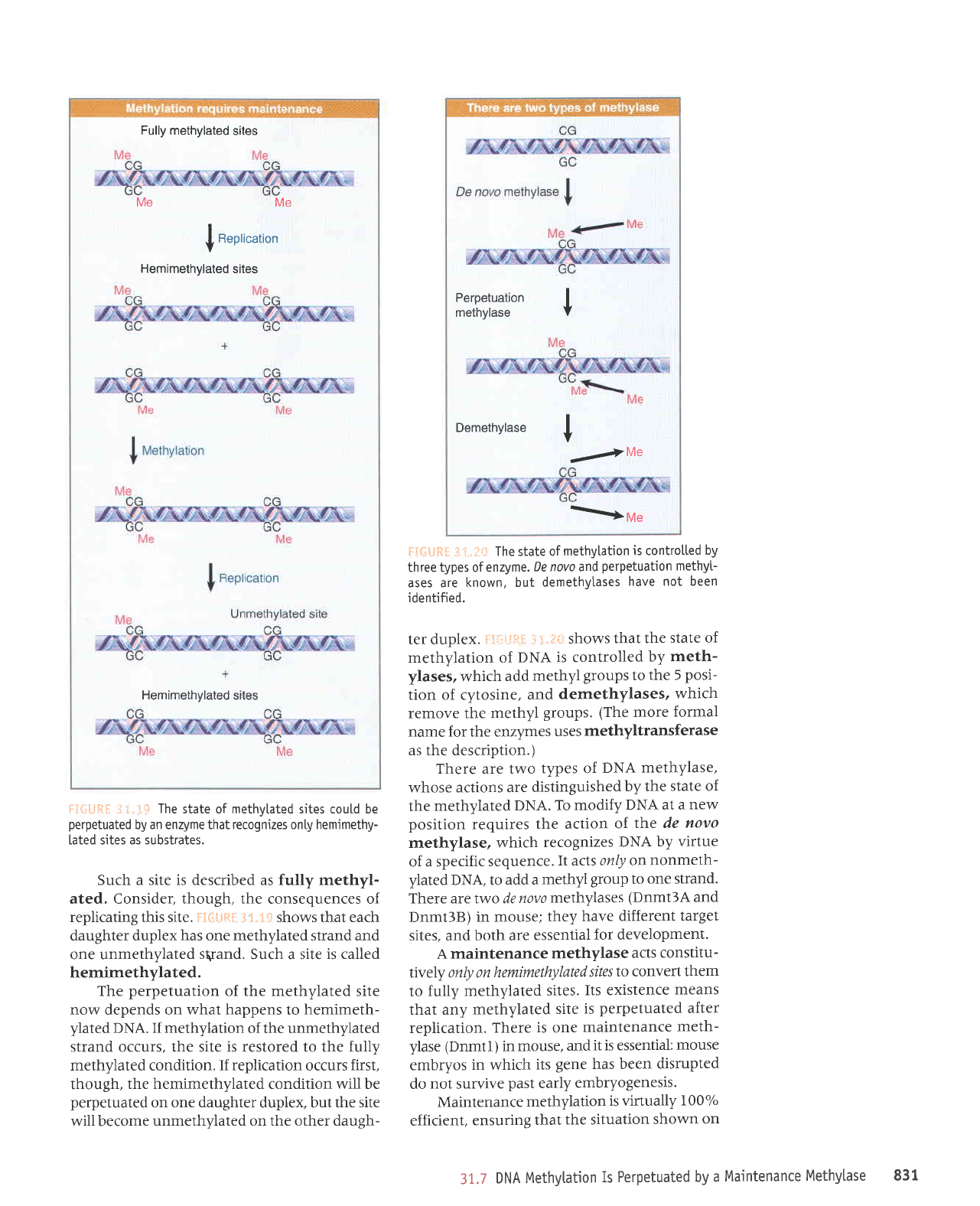
Fully methylated
sites
Me
Me
I
J
Replication
V
Hemimethylated sites
Hemimethylated
sites
Fi{;l-i€i --t i.tt
The
state of methylated sites cou[d be
perpetuated
by an enzyme that recognizes onty hemimethy-
lated sites as substrates.
Such a site is described
as
fully methyl-
ated. Consider, though, the consequences of
replicating this site. F:ii*.ql
3
t"'i:: shows that each
daughter duplex has one methylated strand and
one unmethylated
sgand.
Such a site
is called
hemimethylated.
The
perpetuation
of the methylated site
now depends on
what happens
to
hemimeth-
ylated
DNA.
If methylation
of the unmethylated
strand occurs, the site is restored to the fully
methylated condition.
If replication
occurs
first,
though,
the hemimethylated condition will be
perpetuated
on one
daughter
duplex, but
the site
will become
unmethylated on the other daugh-
Perpetuation
methylase
I
Demethylase
I
t-tc'>X1"
\rve
F5{.i1.1fiil
"":
li .Ii=:
The state of
methylation
is controlted
by
three types ofenzyme.
De novo and
perpetuation
methyl
ases are
known, but demethytases
have not been
identified.
ter duplex. fi:*ilFiil
.i .i"t*
shows
that the
state of
methylation of
DNA is controlled
by meth-
ylases,
which
add
methyl
groups
to
the 5
posi-
tion of cytosine,
and
demethylases,
which
remove the methyl
groups.
(The
more
formal
name
for the enzymes
uses
methyltransferase
as the description.)
There are two
types of
DNA
methylase,
whose actions are
distinguished
by the
state of
the
methylated
DNA. To
modify
DNA at a
new
position
requires
the action
of
the de novo
methylase,
which
recognizes
DNA
by virtue
of a specific
sequence.
Ir acts only
on nonmeth-
ylated
DNA, to
add a
methyl
group
to
one strand.
There are two de
novo
methylases
(Dnmt3A
and
Dnmt3B)
in mouse;
they
have different
target
sites, and
both are
essential
for development.
A maintenance
methylase
acts
constitu-
tively
lnly on hemimethylated
sites
to convert
them
to fully
methylated
sites.
Its existence
means
that any methylated
site
is
perpetuated
after
replication.
There is one
maintenance
meth-
ylase (Dnmtt
)
in mouse,
and
it is essential:
mouse
embryos
in
which
its
gene
has been
disrupted
do
not
survive
past
early
embryogenesis.
Maintenance
methylation
is virtually
100%
efficient,
ensuring
that
the situation
shown
on
31.7
DNA
Methytation
Is Perpetuated
by a
Maintenance
Methytase 831
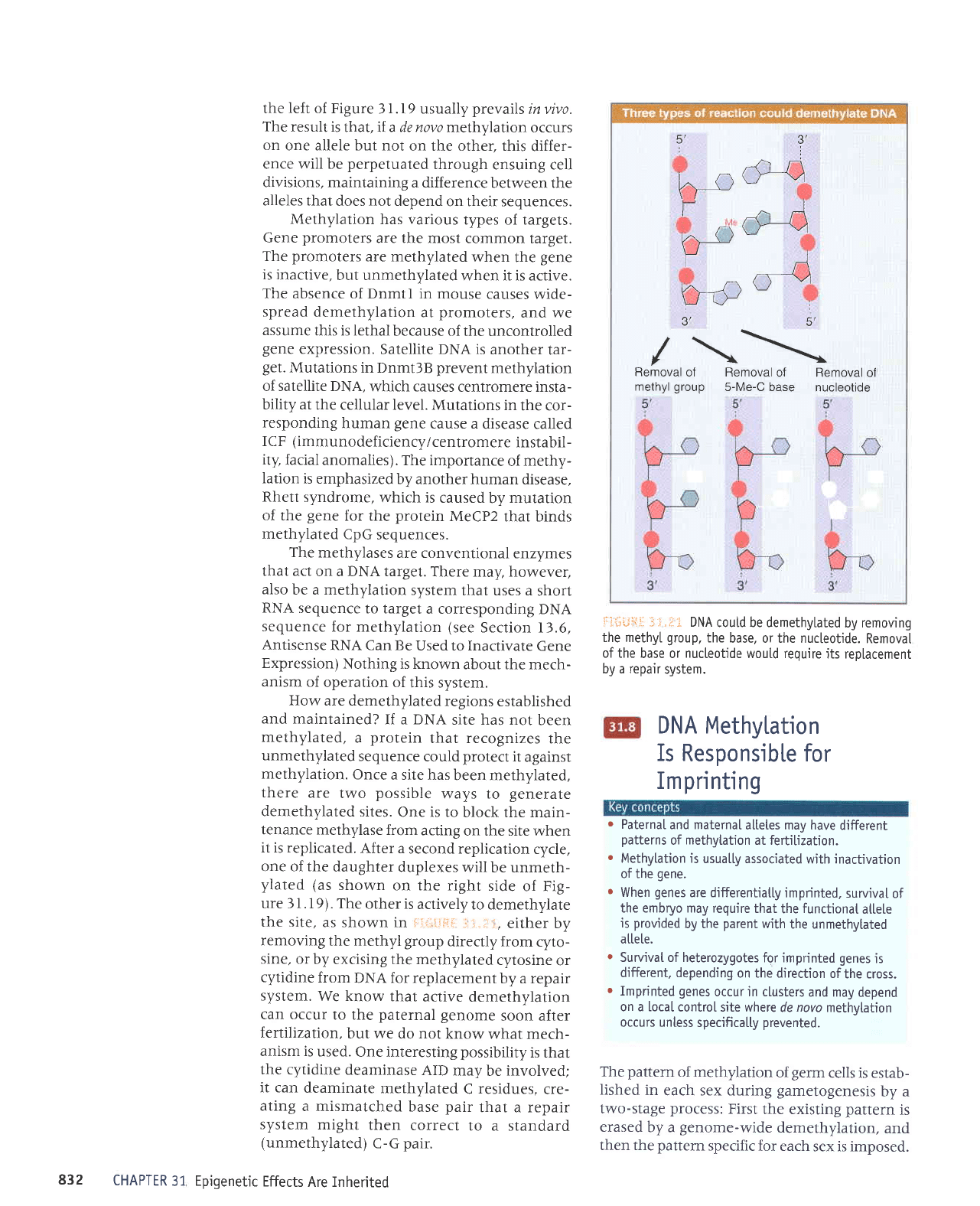
the left of Figure
31.19 usually
prevails
in vivo.
The result is
that, if. a de novo methylation
occurs
on
one allele but not
on the other, this
differ-
ence will be
perpetuated
through
ensuing cell
divisions, maintaining
a difference
between the
alleles that
does not depend
on their sequences.
Methylation
has various
types of rargets.
Gene
promoters
are the most
common target.
The
promoters
are methylated
when
the
gene
is inactive,
but unmethylated
when it is active.
The absence
of DnmtI in
mouse causes
wide-
spread
demethylation
at
promoters,
and we
assume
this is lethal
because of the
uncontrolled
gene
expression.
Satellite DNA
is another
tar-
get.
Mutations
in Dnmt38
prevent
methylation
of satellite DNA,
which causes
centromere insta-
bility at
the cellular level.
Mutations in
the cor-
responding
human
gene
cause a
disease called
ICF
(immunodeficiency/centromere
instabil-
ity,
facial
anomalies). The importance
of
methy-
Iation
is emphasized
by another
human disease,
Rhett
syndrome,
which is
caused
by
mutation
of the
gene
for the
protein
MeCP2
that binds
methylated
CpG
sequences.
The
methylases
are conventional
enzymes
that act
on a DNA target.
There may, however,
also
be a methylation
system
that uses a
short
RNA
sequence
to target
a corresponding
DNA
sequence
for methylation
(see
Section 13.6,
Antisense
RNA Can Be
Used to Inactivate
Gene
Expression)
Nothing is known
about the mech-
anism
of
operation of
this system.
How
are demethylated
regions
established
and maintained?
If a DNA
site has not
been
methylated,
a
protein
that recognizes
the
unmethylated
sequence
could
protect
it
against
methylation.
Once
a site has
been methylated,
there
are
two
possible
ways to
generate
demethylated
sites.
One is to
block the main-
tenance methylase
from
acting
on the site when
it is replicated.
After a
second replication
cycle,
one of the
daughter
duplexes
will be unmeth-
ylated (as
shown
on the right
side
of Fig-
ure
31. l9). The
orher is
acrively
to demethylate
the site,
as shown
in i:li.i,:*I
"ii".;t
l,
either by
removing
the
methyl
group
directly from
cyto-
sine,
or by
excising the methylated
cytosine
or
cytidine
from
DNA for replacement
by a repair
system.
We know
that
active
demethylation
can occur
to the
paternal
genome
soon after
fertilization,
but we do not
know
what mech-
anism is
used.
One interesting possibility
is that
the cytidine
deaminase
AID
may
be
involved;
it can
deaminate
methylated
C
residues,
cre-
ating
a mismatched
base
pair
that a repair
system
might
then
correct
to a standard
(unmethylated)
C-G
pair.
Epigenetic
Effects
Are Inherited
?,
?,
.- fl
| /
-\
\ /'-
-\,1
kH-
l/-.;
-1l\
n
(
,n/
rw-
l-
.{
1-l
---v
}#U
3',
5'
/\\
Removal
of Removal
of Removal
ol
methyl
group
S-Me-C base
nucleotide
::i**itf,
-::;i.i:li DNA
coutd be demethylated
by removing
the methyl
group.
the
base. or the nucleotide.
Removal
of the
base or
nucteotide
woutd reouire
its replacement
by a repair
system.
DNA Methylation
Is
Responsible for
Imprinting
.
Paternal
and maternal
altetes may have
different
patterns
of
methytation
at fertilization.
r
Methylation is
usua[[y associated
with inactivation
of the
gene.
r
When
genes
are differentiatty
imprinted,
survival
of
the embryo may require
that
the
functional
altele
is
provided
by the
parent
with
the unmethytated
attete.
o
Survival of heterozygotes
for imprinted
genes
is
different, depending
on the direction
of
the cross.
r
Imprinted
genes
occur in clusters
and may
depend
on a [oca[
control site where
de
norzo
methylation
occurs unless
specifica[[y
prevented.
The
pattern
of methylation
of
germ
cells is estab-
Iished
in
each sex during
gametogenesis
by a
two-stage
process:
First
the existing
pattern
is
erased
by a
genome-wide
demethylation,
and
then the
pattem
specific
for each
sex is imposed.
832
CHAPTER
31
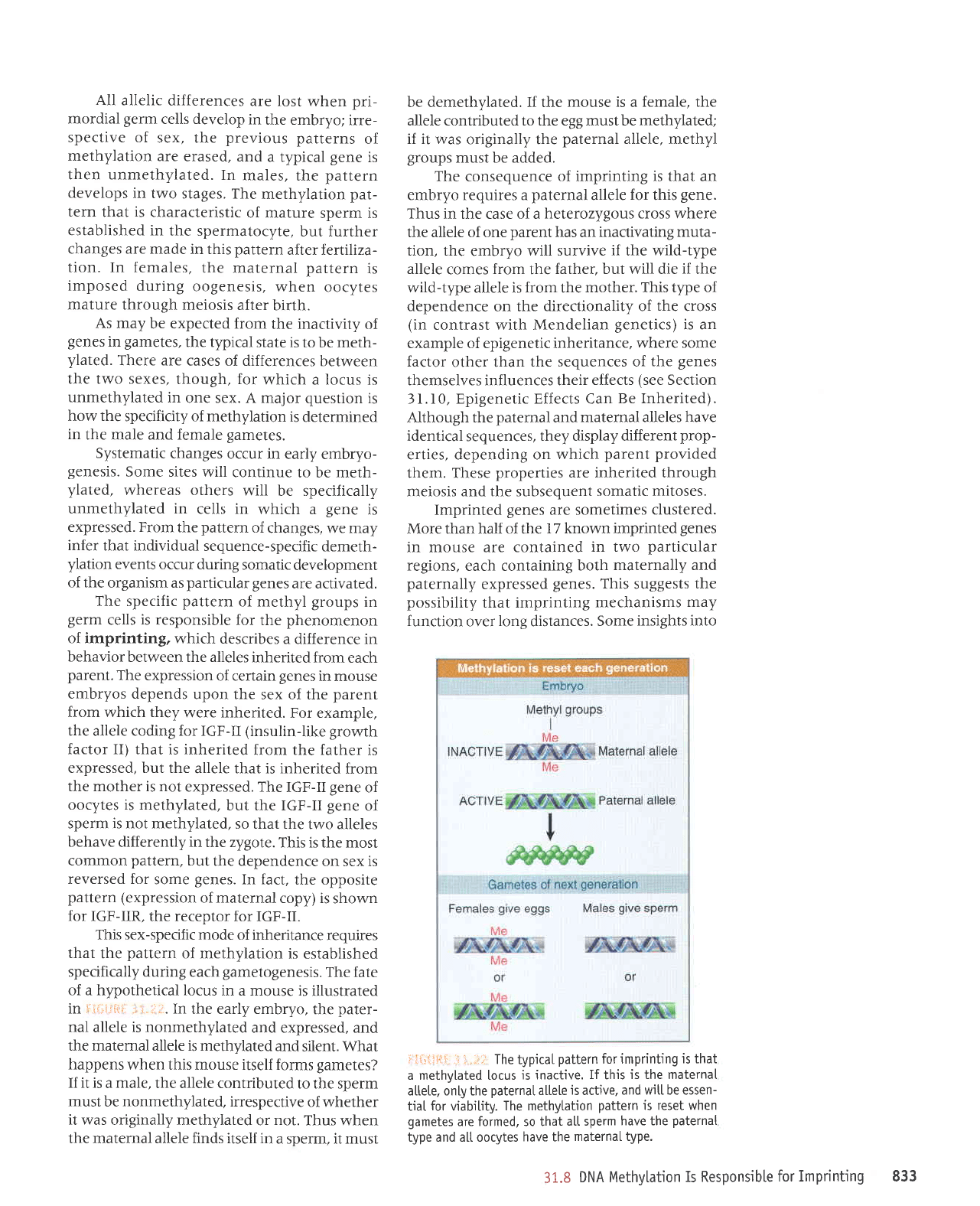
All allelic
differences
are losr
when
pri-
mordial
germ
cells develop
in
the embryo;
irre-
spective of
sex, the
previous
patterns
of
methylation
are
erased, and
a typical
gene
is
then unmethylated.
In
males,
the
pattern
develops
in two
stages. The
methylation
pat-
tern
that
is
characteristic
of mature
sperm is
established in
the spermatocyte,
but further
changes are made
in this
pattern
after fertiliza-
tion. In females,
the maternal pattern
is
imposed
during
oogenesis,
when
oocytes
mature
through meiosis
after
birth.
As may
be expected from
the inactivity
of
genes
in
gametes,
the typical
state is
to be meth-
ylated.
There are
cases of differences
between
the two sexes,
though, for
which
a
locus
is
unmethylated
in
one sex. A
major
question
is
how the
specificity of methylation
is
determined
in
the male and female gametes.
Systematic
changes
occur in
early embryo-
genesis.
Some sites will
continue
to be meth-
ylated,
whereas others
will
be specifically
unmethylated in
cells in
which a
gene
is
expressed. From
the
pattern
of
changes, we may
infer
that individual
sequence-specific
demeth-
ylation
events
occur during
somatic
development
of the
organism as
particular
genes
are activated.
The specific
pattern
of methyl groups
in
germ
cells
is
responsible
for the
phenomenon
of imprinting,
which describes
a difference in
behavior
between the alleles
inherited
from each
parent.
The
expression
of certain
genes
in mouse
embryos depends
upon the
sex of the
parent
from which they
were inherited.
For example,
the allele coding for IGF-II
(insulin-like
growth
factor II) that
is inherited
from the father
is
expressed, but the
allele that is inherited
from
the mother is not
expressed. The
IGF-II
gene
of
oocytes is methylated,
but the IGF-II
gene
of
sperm is not methylated,
so that the
two alleies
behave
differently in the zygote.
This is the most
common
pattern,
but
the dependence
on sex is
reversed for
some
genes.
In fact,
the opposite
pattern (expression
of maternal
copy) is
shown
for
IGF-IIR, the receptor
for IGF-II.
This sex-specific mode
of inheritance
requires
that
the
pattern
of methylation
is established
specifically during
each
gametogenesis.
The
fate
of a hypothetical locus
in a mouse is
illustrated
in
liiji.iiii:
:1
i..:1.j.
In
the early embryo,
the
pater-
nal
allele
is
nonmethylated
and expressed, and
the matemal allele is methylated
and
silent. What
happens
when this mouse itself forms
gametes?
If it is
a
male,
the allele contributed
to the sperm
must
be
nonmethylated,
irrespective
of whether
it
was originally methylated
or
not.
Thus when
the maternal allele finds itself in
a sDerm. it must
be demethylated. If the mouse
is
a
female, the
allele contributed to the egg must be
methylated;
if it was
originally the
paternal
allele, methyl
groups
must be added.
The
consequence
of imprinting is that an
embryo requires a
paternal
allele
for
this
gene.
Thus
in the case of a
heterozygous cross where
the allele of one
parent
has an
inactivating muta-
tion, the
embryo
will survive
if
the wild-type
allele
comes
from
the
father, but will die
if
the
wild-type
allele is from the
mother. This type of
dependence
on the
directionality of
the
cross
(in
contrast with Mendelian
genetics)
is an
example of epigenetic inheritance,
where some
factor
other than
the sequences of
the
genes
themselves influences their
effects
(see
Section
ll.l0. Epigenetic Effects Can
Be Inherited).
Although the
paternal
and
maternal alleles have
identical
sequences,
they display different
prop-
erties, depending on
which
parent provided
them. These
properties
are inherited through
meiosis and the subsequent
somatic mitoses.
Imprinted
genes
are sometimes
clustered.
More than half of the
l7 known imprinted
genes
in mouse are contained
in two
particular
regions,
each containing
both
maternally and
paternally
expressed
genes.
This suggests
the
possibility
that imprinting
mechanisms
may
function
over
long
distances.
Some
insights into
llt:{l!'ll :i
1
",:
i
The
typicaI
pattern
for imprinting
is that
a methylated [ocus
is inactive.
If
this
is the maternaI
attete, on[y the
paternal
altele
is
active,
and wit[ be essen-
tia[
for
viabitity.
The methytation
pattern
is reset when
gametes
are formed, so that
a[[ sperm
have the
paternal
type and a[[ oocytes
have the
maternal type.
31.8
DNA Methytation
Is Responsibte
for imprinting 833
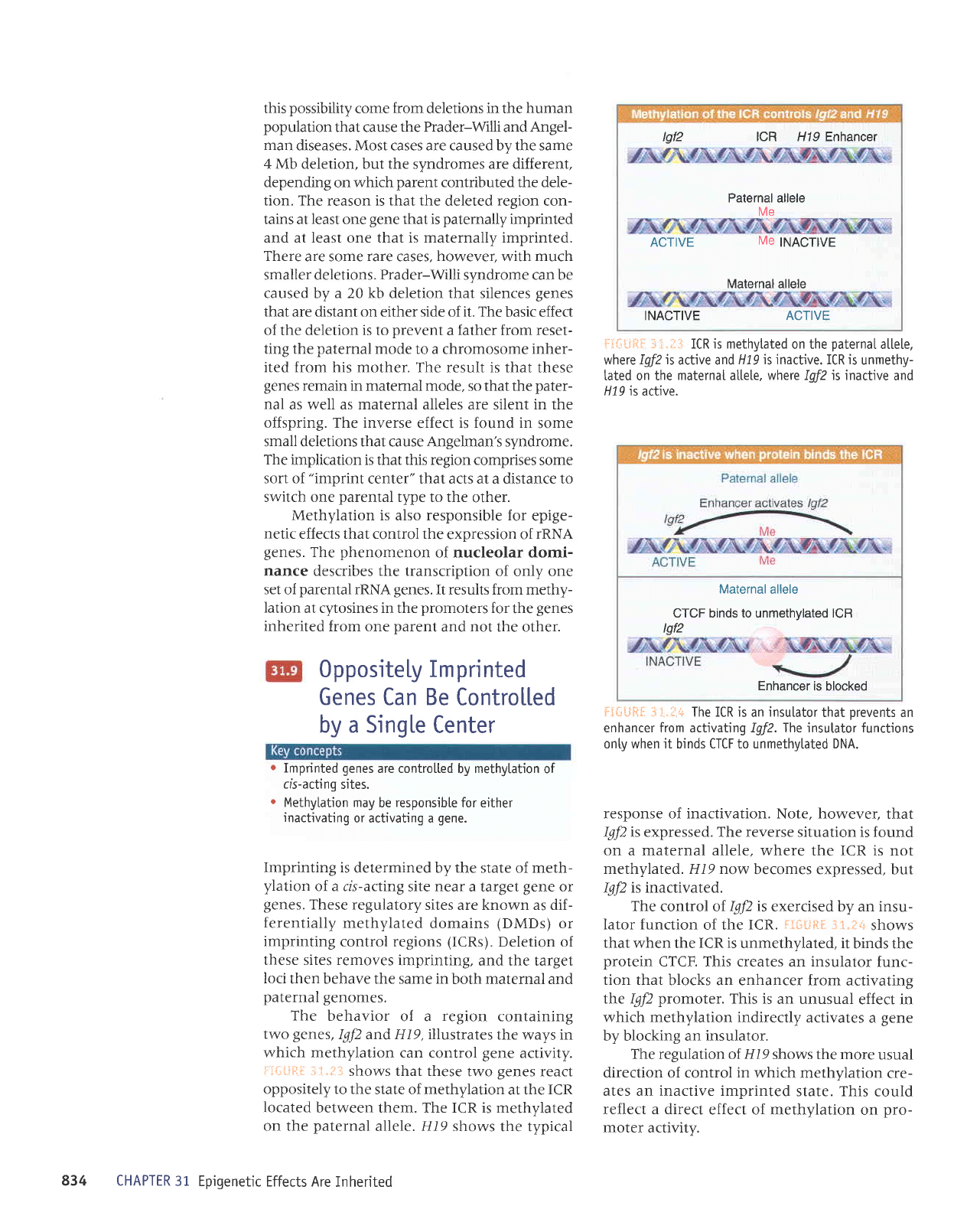
this
possibility
come from deletions in the human
population
that cause
the Prader-Willi
and
Angel-
man
diseases. Most cases are caused by the same
4 Mb deletion, but the syndromes are different,
depending
on
which
parent
contributed the dele-
tion. The reason is that the
deleted
region
con-
tains at
least
one
gene
that
is
paternally
imprinted
and at least one that is maternally imprinted.
There
are some
rare
cases.
however.
with
much
smaller deletions. Prader-Willi syndrome can be
caused by a 20 kb deletion that silences
genes
that are distant on either side
of
it. The
basic effect
of the deletion
is
to
prevent
a father from reset-
ting the
paternal
mode
to a chromosome
inher-
ited from his
mother. The result is that these
genes
remain in matemal mode, so that the
pater-
nal
as well as maternal alleles are silent in the
offspring. The inverse
effect
is found in
some
small deletions that cause Angelman's syndrome.
The implication
is that this region comprises
some
sort of
"imprint
center" that acts at a distance to
switch one
parental
tlpe to the
other.
Methylation is also responsible for
epige-
netic effects that control the
expression of
rRNA
genes.
The
phenomenon
of nucleolar domi-
nance describes the transcription
of only one
set
of
parental
rRNA
genes.
It results from methy-
lation
at cytosines in the
promoters
for
the
genes
inherited
from one
Darent and
not
the other-
0ppositeLy
Imprinted
Genes
Can
Be
Controlled
by a SingLe
Center
r
Imprinted
genes
are controlted
by
methylation
of
crs-acting
sites.
o
Methylation may
be
responsibte
for either
inactivating
or activating a
gene.
Imprinting
is
determined by the state of meth-
ylation
of a cli-acting
site
near
a target
gene
or
genes.
These regulatory
sites are known as dif-
ferentially
methylated
domains
(DMDs)
or
imprinting
control regions
(ICRs).
Deletion of
these sites removes
imprinting,
and the target
loci
then behave the same in
both maternal and
paternal
genomes.
The
behavior
of a
region
containing
two
genes,
Igp and I119, illustrates
the ways in
which methylation
can control gene
activity.
::ii,i.:::i
:i..i*i
shows that these
two
genes
react
oppositely to the
state of methylation
at the
ICR
located
between them. The ICR is methylated
on the
paternal
allele. I1.19 shows
the typical
Epigenetic
Effects Are
Inherited
lgt2 ICR H79
Enhancer
Paternal allele
Me
ACTIVE
ME
INACTIVE
Maternal allele
INACTIVE ACTIVE
f,i{**F
.i:.":ii ICR is methytated
on the
paternaI
atlete,
where
lgf2 is
active and
H19 is inactjve. ICR is
unmethy-
lated on the
maternal
atlele,
where IgF2 is inactive
and
H19 is
active.
+:3*LiRf
3
i.t*
The ICR is
an
insulator
that
prevents
an
enhancer from actjvating lgf2. Ihe insulator functions
onty when it binds CTCF to unmethytated DNA.
response of inactivation.
Note.
however,
that
Igf2 is expressed. The reverse situation
is found
on a maternal allele, where
the ICR is not
methylated. H19 now
becomes expressed,
but
Igf2 is inactivated.
The
control of
lgp is
exercised by an insu-
lator function
of the
ICR.
fl**it$.
-q1.il4
shows
that when
the
ICR is
unmethylated, it
binds the
protein
CTCF. This creates an insulator
func-
tion that
blocks an enhancer from
activating
Ihre lgp
promoter.
This is
an unusual
effect in
which methylation
indirectly activates
a
gene
by blocking an insulator.
The regulation
of
I1l9
shows the more
usual
direction
of control
in
which methylation
cre-
ates an inactive imprinted
state. This
could
reflect a direct
effect of methvlation
on Dro-
moter
activity.
Maternal
allele
CTCF binds to unmethylated ICR
tgf2
Enhancer is blocked
834 CHAPTER
31
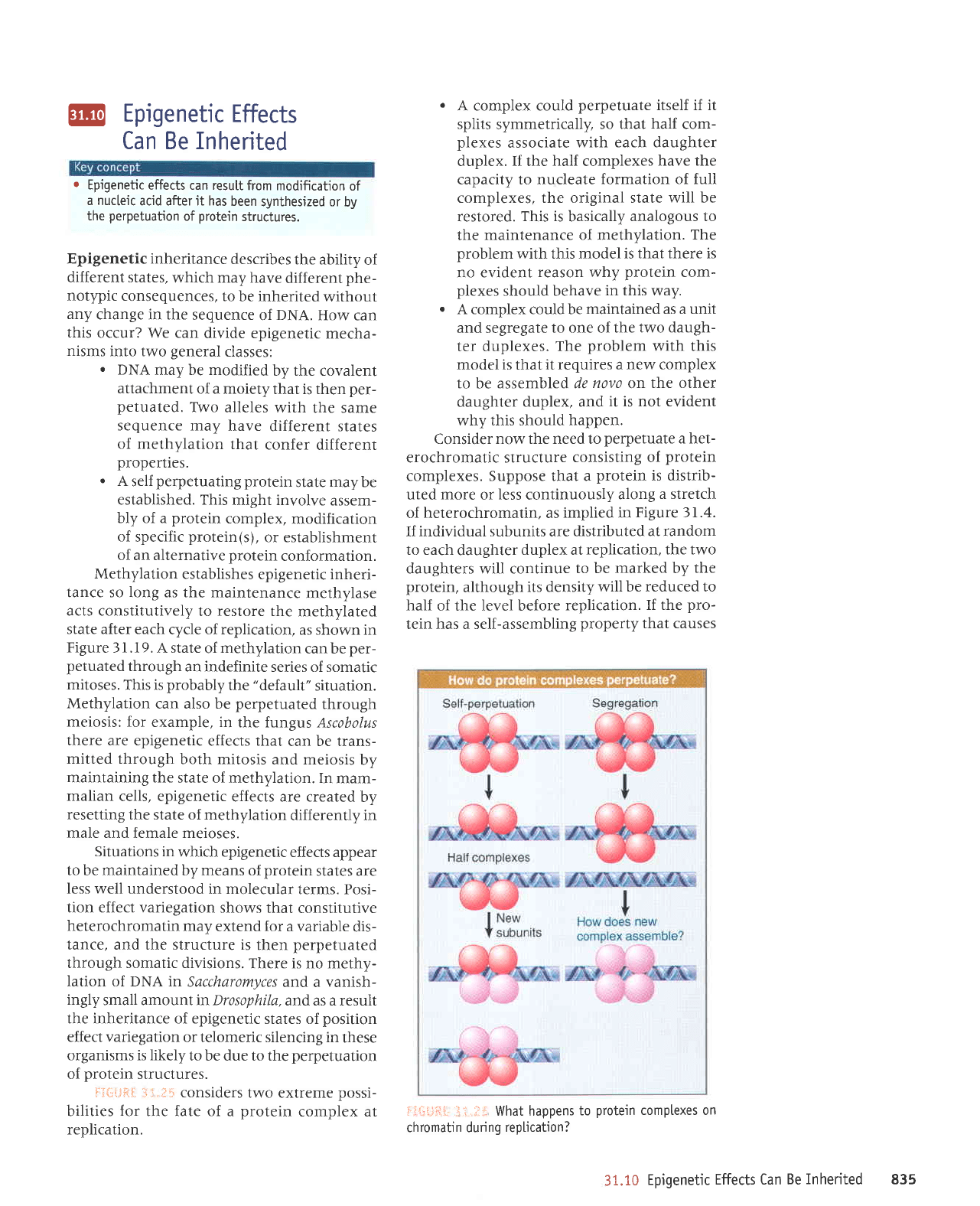
@
Epigenetic
Effects
Can Be Inherited
.
Epigenetic
effects can resutt
from modification
of
a nucleic
acid after
jt
has
been
synthesized or
by
the
perpetuation
of
protein
structures.
Epigenetic inheritance
describes
the ability
of
different states,
which may
have
different
phe-
notypic consequences,
to be inherited
without
any
change in the
sequence
of
DNA.
How
can
this
occur? We can
divide epigenetic
mecha-
nisms
into two
general
classes:
.
DNA
may be modified
by the covalent
attachment
of a moiety
that is then
per-
petuated.
TWo
alleles with
the same
sequence may
have
different states
of methylation
that
confer
different
properties.
.
A
self
perpetuating
protein
state may be
established. This
might involve
assem-
bly of a
protein
complex,
modification
of
specific
protein(s),
or establishment
of an alternative
protein
conformation.
Methylation
establishes
epigenetic inheri-
tance so long as the maintenance
methylase
acts constitutively
to restore the
methylated
state after each
cycle of replication,
as shown in
Figure
31.19. A state
of methylation
can be
per-
petuated
through
an indefinite
series of somatic
mitoses.
This is
probably
the
"default"
siruarion.
Methylation
can also be
perpetuated
through
meiosis:
for example, in
the fungus Ascobolus
there are epigenetic
effects that
can be trans-
mitted through
both mitosis
and meiosis
by
maintaining the
state of methylation.
In mam-
malian
cells, epigenetic
effects are created
by
resetting
the state of methylation
differently in
male and female meioses.
Situations in
which epigenetic
effects appear
to be maintained by means
of
protein
states are
less well understood
in molecular
terms. Posi-
tion effect variegation
shows that
constitutive
heterochromatin
may
extend for a variable
dis-
tance, and the structure is
then
perpetuated
through somatic divisions.
There is no methy-
Iation of DNA in
Saccharomyces
and a vanish-
ingly
small amount inDrosophila,
and as a result
the inheritance of epigenetic
states of
position
effect
variegation
or telomeric silencing in
these
organisms is likely
to be due to the
perpetuation
of
protein
structures.
i:iiiliF.l I
i.;t:; considers
two extreme
possi-
bilities
for
the fate of a
protein
complex at
replication.
.
A complex could
perpetuate
itself if it
splits
symmetrically,
so that
half
com-
plexes
associate
with each daughter
duplex. If the
half
complexes
have the
capacity to nucleate
formation of full
complexes, the original state will be
restored.
This is
basically
analogous to
the
maintenance of methylation.
The
problem
with this model
is that there is
no evident
reason
why
protein
com-
plexes
should behave
in this way.
.
A complex could be
maintained as a unit
and
segregate
to one of the
two daugh-
ter duplexes.
The
problem
with this
model is that
it requires a new complex
to
be
assembled de
novl
orr
the other
daughter duplex,
and
it is not evident
why this should
happen.
Consider
now the need to
perpetuate
a het-
erochromatic structure
consisting of
protein
complexes. Suppose that a
protein
is distrib-
uted
more
or
less
continuously
along
a stretch
of heterochromatin, as
implied in
Figure 31.4.
If individual subunits are distributed
at random
to each
daughter
duplex at
replication, the two
daughters will continue
to be marked by
the
protein,
although
its density
will be reduced to
half
of the level before
replication.
If the
pro-
tein has a self-assembling
property
that causes
ll+Ljitl- .i{'1
,il:
What happens
to
protein
comptexes on
chromatin during
replication?
31.10
Epigenetic
Effects Can Be
Inherited 83s
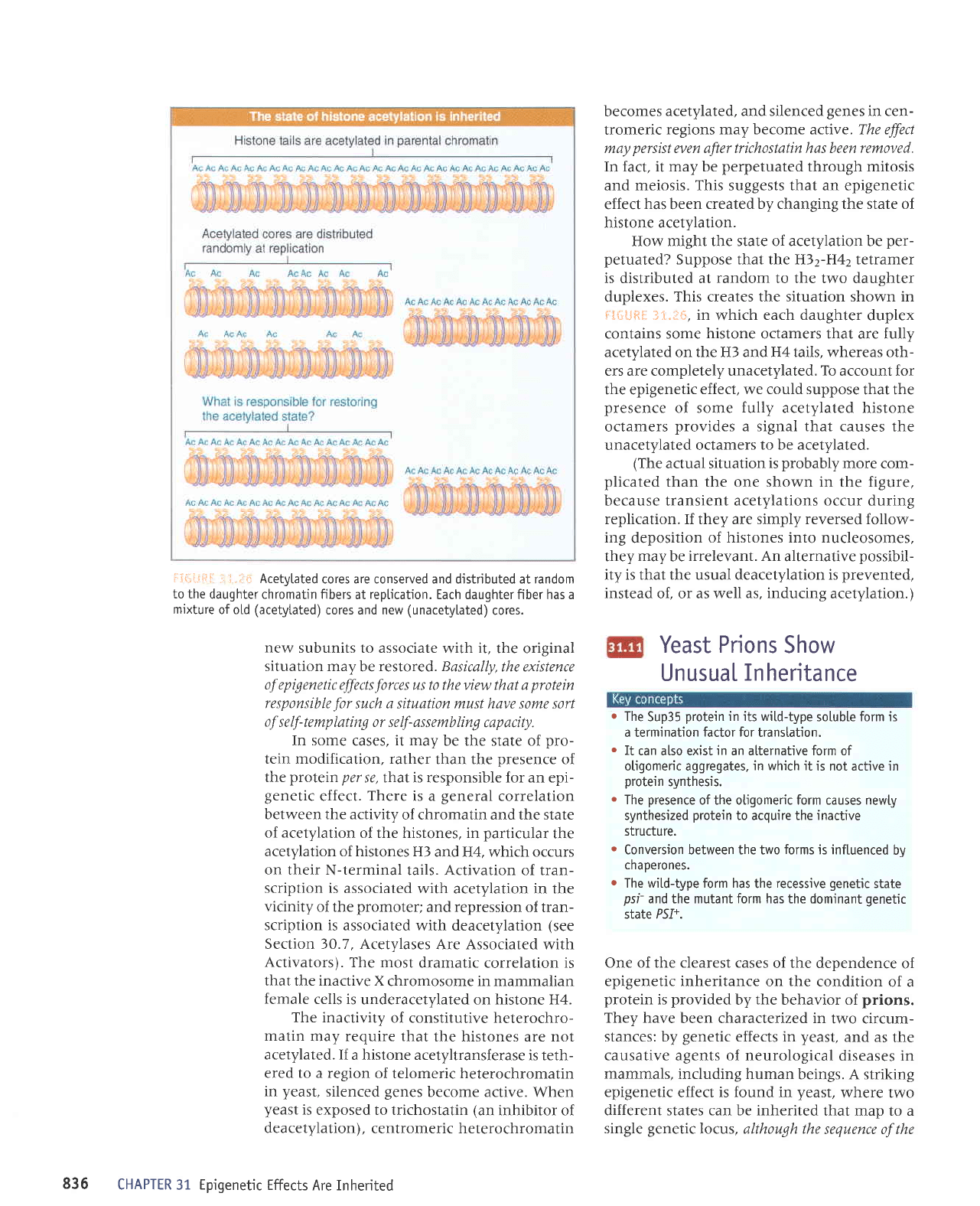
iii-]..:i:i
=:: I.iri-_:
Acetytated
cores are conserved and djstributed at random
to the
daughter chromatin fibers
at
reptication.
Each daughter fiber has a
mixture
ofotd
(acetytated)
cores and new
(unacetylated)
cores.
new
subunits to associate
with
it,
the original
situation may
be
restored. Basically,
the existence
of epigenetic
effects
flrces
us t0 the view that a
protein
responsible
for
such a situatiln must h6ve slme slrt
of
s e
lf-
temp lating or se lf- as
s
emb ling
cap acity.
In some
cases,
it may
be the state of
pro-
tein modification, rather
than the
presence
of
the
protein per
se, rhar is responsible for an epi-
genetic
effect.
There
is a
general
correlation
between the activity
of chromatin and the state
of acetylation
of the histones, in
particular
the
acetylation of histones H3
and H4, which occurs
on their
N-terminal tails. Activation of tran-
scription
is associated with
acetylation in the
vicinity
of the
promoter;
and
repression
of tran-
scription is
associated with deacetylation
(see
Section 30.7, Acetylases
Are Associated with
Activators).
The most
dramatic
correlation
is
that the inactive X
chromosome in mammalian
female
cells is
underacetylated on histone H4.
The inactivity
of constitutive heterochro-
matin
may require that
the histones are not
acetylated. If
a histone acetyltransferase
is teth-
ered to a region
of telomeric heterochromatin
in
yeast,
silenced
genes
become active.
When
yeast
is
exposed to trichostatin
(an
inhibitor of
deacetylation),
centromeric heterochromatin
CHAPTER
31
Epigenetic
Effects
Are Inherited
becomes
acetylated, and silenced
genes
in cen-
tromeric
regions may become active. The effect
may
persist
even after trichostatin has been removed.
In fact, it may be
perpetuated
through mitosis
and meiosis. This suggests that an epigenetic
effect
has
been
created by changing the state of
histone acetylation.
How might the state of acetylation be
per-
petuated?
Suppose that the H)2-H42 tetramer
is distributed at
random
to the two daughter
duplexes.
This creates the situation shown in
tiGi-iftil
]1.1$, in
which
each daughter
duplex
contains some
histone
octamers that are fully
acetylated on the H3 and H4 tails, whereas oth-
ers are completely unacetylated.
To
account lor
the epigenetic
effect, we could suppose
that the
presence
of some
fully
acetylated histone
octamers
provides
a signal that causes
the
unacetylated octamers
to be acetylated.
(The
actual situation
is
probably
more com-
plicated
than the one shown in the figure,
because transient acetylations occur during
replication. If they are simply reversed follow-
ing
deposition
of histones into nucleosomes,
they
may
be
irrelevant. An
alternative
possibil-
ity is that the usual deacetylation is
prevented,
instead
of, or as well
as, inducing
acetylation.)
Yeast Prions
Show
UnusuaL
Inheritance
o
The
Sup35
protein
in its wild-type
soluble form is
a termination
factor for
transtation.
r
It
can also exist
in
an atternative form of
otigomeric aggregates.
in which it
is not actjve in
protein
synthesis.
.
The
presence
of the otigomeric form causes newty
synthesized
protein
to acquire the inactive
structure.
.
Conversion between the two
forms'is
influenced
bv
cnaDer0nes.
o
The witd-type form has
the
recessive
genetic
state
psr
and the mutant form has the dominant
genetic
state P5.[+.
One of the clearest cases
of the dependence
of
epigenetic inheritance
on
the
condition
of a
protein
is
provided
by
the
behavior of
prions.
They have
been characterized in
two circum-
stances: by
genetic
effects in
yeast,
and as
the
causative agents of neurological
diseases in
mammals, including human
beings. A striking
epigenetic
effect
is found
in
yeast,
where two
different states can be inherited
that map to a
single
genetic
locus, although the
sequence of the
836
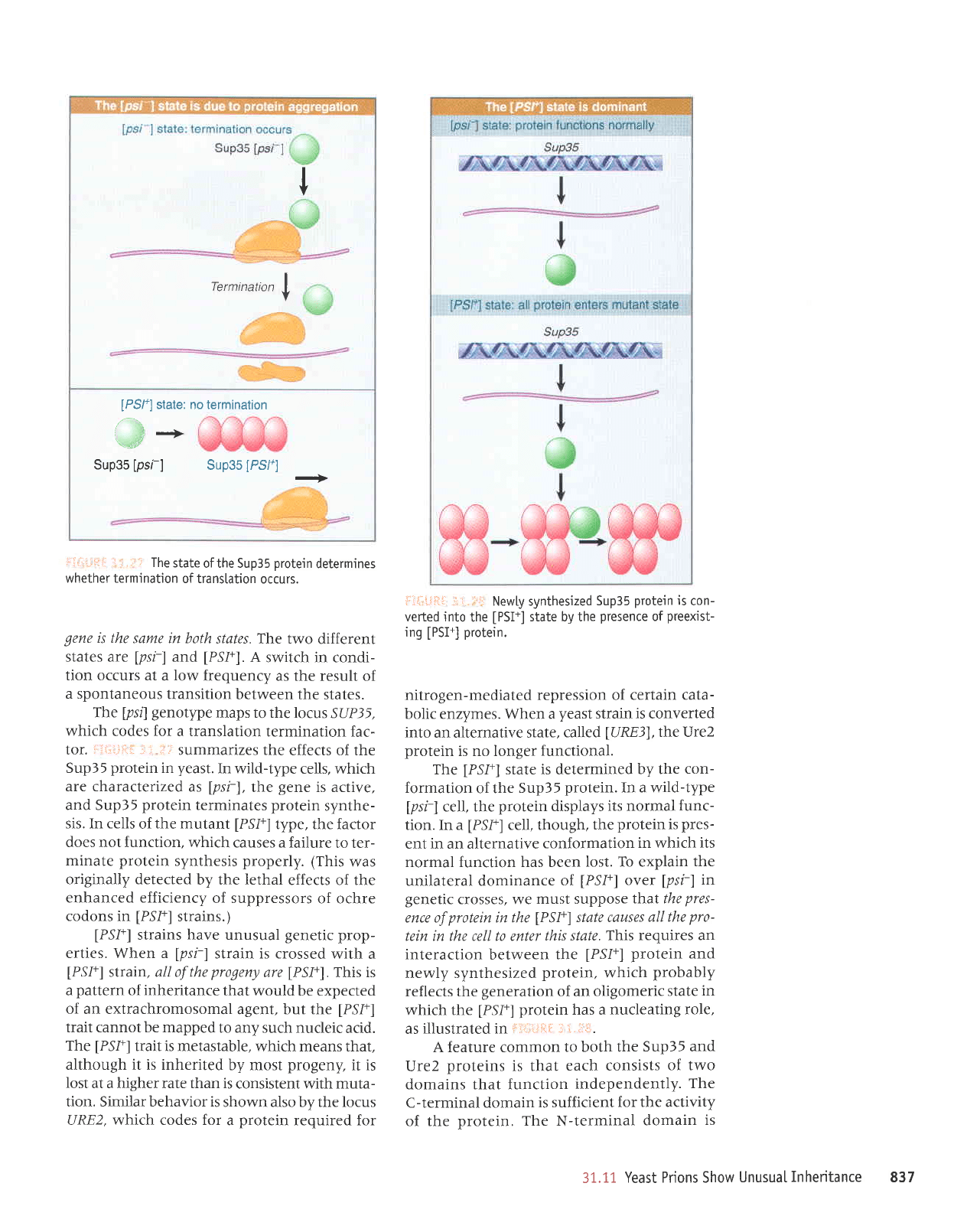
I
Termination
f
[PSl+]
state: no termination
a
i
---*
Sup35
[psl-]
Sup35
[PS/.]
-.>
:ilii-jt:::
r:
i,.i:r
The
state
of the Sup35
protein
determines
whether termination
of transtation
occurs.
gene
is the
same in both
states. The two
different
states are
lpsi-l
and
[PSI+].
A
switch in condi-
tion occurs at
a
low
frequency
as the result
of
a spontaneous
transition
between the
states.
The
[ps{
genotype
maps to the locus
SUP35,
which
codes for a translation
termination fac-
tor.
l:l,i.i!iir
-i: .':l'
summarizes the
effects of the
Sup35
protein
in
yeast.
In wild-type
cells, which
are characterized
as
lpsi),
the
gene
is active,
and Sup35
protein
terminates
protein
synthe-
sis. In cells
of
the mutant
[PSI+]
type, the factor
does not function,
which causes a failure
to ter-
minate
protein
synthesis
properly.
(This
was
originally detected
by the lethal
effects of the
enhanced efficiency
of suppressors
of ochre
codons in
[PSI+]
strains.)
[PS1+]
strains have unusual
genetic
prop-
erties. When a
lpsi-l
strain is crossed
with a
[PSI+]
strain, all of the
prlgeny
are
IPSF).
This is
a
pattern
of
inheritance
that
would be expected
of an extrachromosomal
agent, but the
[PSI+]
trait cannot be mapped
to any such nucleic
acid.
The
[PSI+]
trait is metastable,
which means that,
although it is inherited
by most
progeny,
it is
Iost
at a higher rate than is
consistent with muta-
tion. Similar behavior is
shown also by the locus
URE2, which codes for
a
protein
required for
fi{.;tiiii -i
r.,:r::
Newly synthesized
Sup35
protein
is
con-
verted into
the
IPSI+]
state by the
presence
of
preexist-
ing
IPSI+]
protein.
nitrogen-mediated
repression of certain
cata-
bolic enzymes. When a
yeast
strain is converted
into
an alternative state,
called
lURE3l,
the Ure2
protein
is no longer
functional.
The
[PSI+]
state is determined
by the
con-
formation
of the
Sup35
protein.
In a wild-type
[psi-]
cell, the
protein
displays
its normal
func-
tion. In a
[PSI+]
cell, though,
the
protein
is
pres-
ent in an alternative
conformation
in which
its
normal function has been
lost. To explain
the
unilateral dominance
of
[PSI+]
over
[psi-]
in
genetic
crosses, we
must suppose
that the
pres-
ence of
protein
in the
lPSfl
rtatu causes
all the
pro-
tein in the cell to enter
this state.
This requires an
interaction
between
the
[PSI+]
protein
and
newly synthesized
protein,
which
probably
reflects the
generation
of
an oligomeric
state
in
which the
[PSI+]
protein
has a
nucleating role,
as illustrated
in
iii':i.iFlf; -i i.iil-i.
A feature common
to both the
Sup35 and
Ure2
proteins
is that
each consists
of two
domains that function
independently.
The
C-terminal domain
is sufficient
for the activity
of the
protein. The
N-terminal
domain
is
3L.11
Yeast Prions Show
Unusual
Inheritance 837
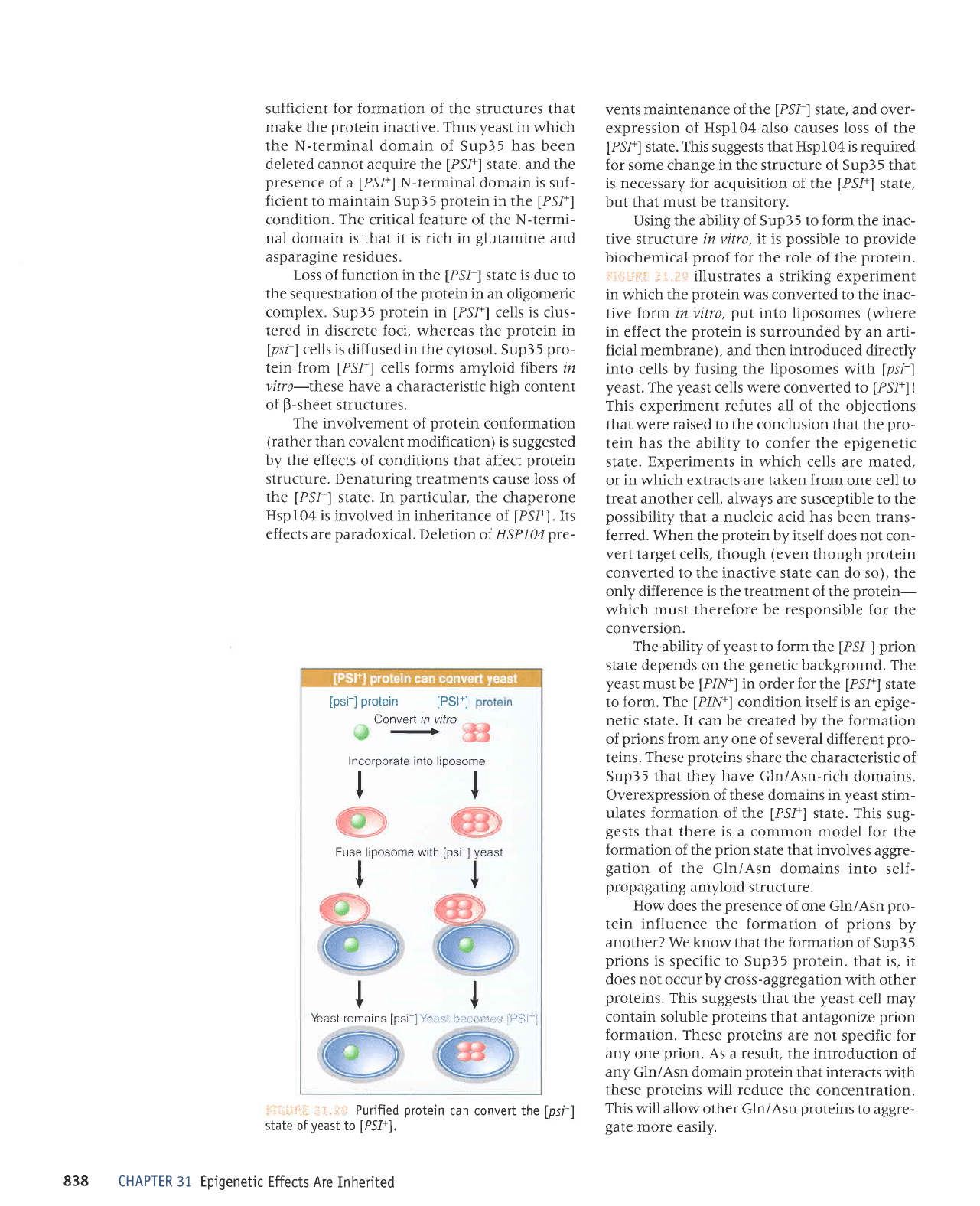
sufficient for formation of the structures that
make the
protein
inactive. Thus
yeast
in which
the N-terminal domain of Sup35 has been
deleted cannot acquire the
[PS/+]
state, and the
presence
of a
[PS1+]
N-terminal domain is suf-
ficient to maintain Sup35
protein
in the
[PS1+]
condition. The critical feature of the N-termi-
nal domain is that it is rich in
slutamine
and
asparagine residues.
Loss
o{ function in the
[PSI+]
state is due to
the sequestration of the
protein
in an oligomeric
complex. Sup35
protein
in
[PSI+]
cells
is
clus-
tered in
discrete foci, whereas the
protein
in
[psr]
cells is
diffused
in the
cytosol. Sup3 5
pro-
tein from
[PS1+]
cells forms amyloid fibers ir
vitro-these
have a characteristic hish content
of
B-sheet
structures.
The involvement
of
protein
conformation
(rather
than covalent modification) is
suggested
by the
effects of conditions that affect
protein
structure.
Denaturing treatments cause loss of
the
[PS1+]
state. In
particular,
the chaperone
Hsp
104 is involved in inheritance
of
[PSI+].
Its
effects are
paradoxical.
Deletion
of. HSPl04pre-
vents maintenance of the
[PSI+]
state, and over-
expression of
Hsp104 also
causes
loss
of
the
[PSI+]
state. This suggests that Hspl04 is required
for some change in the structure of Sup3 5 that
is necessary for acquisition of the
[PSI+]
state,
but that
must
be
transitory.
Using the ability of Sup35 to form the inac-
tive structure
in vitro, it is
possible
to
provide
biochemical
proof
for the role of the
protein.
i
ji;i.iii::
:;
.i..i:;r
illustrates a striking experiment
in
which
the
protein
was converted to
the
inac-
tive form in vitro,
put
into
liposomes
(where
in
effect the
protein
is surrounded
by an arti-
ficial membrane), and then introduced directly
into
cells by
fusing the liposomes
with
[psr]
yeast.
The
yeast
cells were converted to
[PS1+]
!
This experiment refutes all of the objections
that
were
raised to the conclusion
that the
pro-
tein has the ability to confer the epigenetic
state.
Experiments in which
cells are mated,
or
in
which extracts are taken
from
one cell to
treat another cell, always are susceptible to the
possibility
that a nucleic acid has
been
trans-
ferred.
When the
protein
by
itself
does not con-
vert target cells, though
(even
though
protein
converted to the inactive state can do so), the
only difference is the treatment
of the
protein-
which must therefore be responsible
for the
converslon.
The
ability of
yeast
to
form
the
[PSI+]
prion
state depends on the
genetic
background. The
yeast
must
be
[PIN+]
in
order for the
[PS1+]
state
to
form. The
[PIN+]
condition itself is
an epige-
netic state. It can be created by the formation
of
prions
from any one of several
different
pro-
teins.
These
proteins
share the characteristic
of
Sup35 that they have Gln/Asn-rich
domains.
Overexpression of these domains in
yeast
stim-
ulates formation of the
[PSI+]
state.
This
sug-
gests
that there
is
a common model for
the
formation of the
prion
state
that
involves
aggre-
gation
of
the
Gln/Asn domains into
self-
propagating
amyloid structure.
How
does the
presence
of one Gln/Asn
pro-
tein influence
the
formation
of
prions
by
another? We know
that the formation
of Sup35
prions
is
specific to Sup35
protein.
that is, it
does not
occur by cross-aggregation
with other
proteins.
This suggests
that the
yeast
cell
may
contain
soluble
proteins
that antagonize
prion
formation. These
proteins
are not
specific for
any
one
prion.
As
a result, the introduction
of
any
Gln/Asn domain
protein
that
interacts
with
these
proteins
will reduce
the concentration.
This will allow
other Gln/Asn
proteins
to
aggre-
gate
more easily.
state'of
u.rr,
affid
protein
can convert the
CHAPTER 31 Epigenetic
Effects
Are inherited
[psi-]
protein
[PSl']
Converl rn vitro
+
Incornoraltr inlo lrnnsome
ll
tv
Fuse
liposome with
[psi
]
yeast
ll
vv
tl
tt
east remains
Lpsi-]
i'i)i.iil
l-:ttt":::1,:l
iF$1']
838
lpsrl
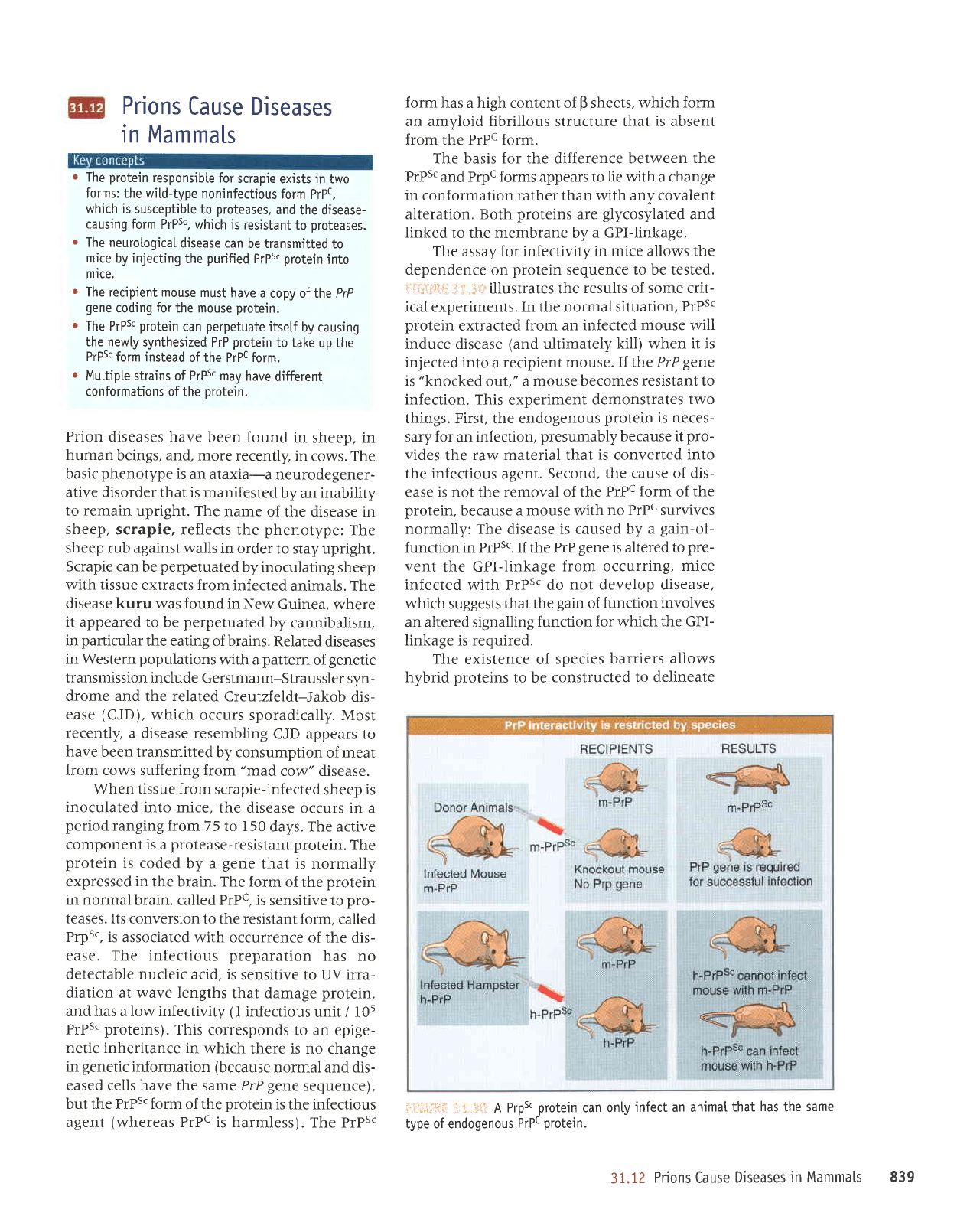
'tn
Prions
Cause Diseases
Mam
ma[s
.
The
protein
responsibte
for
scrapie
exists in two
forms: the
witd-type noninfectious
form
PrPc,
which is
susceptible
to
proteases.
and
the disease-
causing form
PrPsc, which
is resistant
to
proteases.
.
The neurotogical
disease can
be transmitted
to
mice by injecting
the
purified
PrPsc
protein
into
mrce.
o
The recipient mouse
must
have
a copy of the PrP
gene
coding
for
the mouse
protein.
o
The PrPsc
protein
can
perpetuate
itsetf
by causing
the newly
synthesized PrP
protein
to
take up the
PrPsc
form instead
of the PrPc form.
r
Multiple
strains of PrPs.
may have
different
conformations of the
orotein.
Prion
diseases have
been found
in sheep, in
human
beings, and, more
recently,
in cows. The
basic
phenotype
is
an ataxia-a
neurodegener-
ative disorder
that is manifested
by
an
inability
to remain
upright. The
name
of the disease in
sheep,
scrapie, reflects
the
phenotype:
The
sheep rub against
walls
in order
to stay upright.
Scrapie can
be
perpetuated
by inoculating
sheep
with
tissue extracts from
infected
animals. The
disease kuru
was
found in
New Guinea, where
it appeared
to be
perpetuated
by
cannibalism,
in
particular
the eating of brains.
Related
diseases
in Western
populations
with a
pattern
of
genetic
transmission include
Gerstmann-Straussler
syn-
drome and the related
Creutzfeldt-Jakob
dis-
ease
(CJD),
which occurs
sporadically. Most
recently, a disease resembling
CJD appears to
have
been transmitted
by consumption
of meat
from cows suffering
from
"mad
cow" disease.
When
tissue from
scrapie-infected
sheep
is
inoculated
into mice,
the disease
occurs in a
period
ranging from
75 to I50
days. The active
component is a
protease-resistant
protein.
The
protein
is coded
by a
gene
that is normally
expressed
in
the brain. The
form of the
protein
in normal
brain, called PrPc,
is sensitive to
pro-
teases. Its conversion
to the resistant
form, called
Prps', is
associated with
occurrence of the dis-
ease. The inf ectious
preparation
has
no
detectable nucleic acid, is
sensitive to UV irra-
diation at wave lengths
that damage
protein,
and has a low infectivity
(l
infectious
unit / 105
PrPs'proteins). This
corresponds
to an epige-
netic inheritance in
which
there is no change
in
genetic
information
(because
normal and dis-
eased cells have the same PrP
gene
sequence),
but the PrPs'form of the
protein
is the infectious
agent
(whereas
PrPc is harmless).
The PrPs'
form
has a high content of
B
sheets, which
form
an amyloid fibrillous structure that
is
absent
from the PrPc form.
The basis for the difference between
the
PrPs'and Prpc forms appears to
lie
with a change
in
conformation rather than with
any covalent
alteration. Both
proteins
are
glycosylated
and
Iinked
to the membrane by
a GPl-linkage.
The
assay
for infectivity
in mice
allows
the
dependence
on
protein
sequence to be tested.
i.1l:,t;l{t
r; i.
ii;
illustrates the
results of some crit-
ical experiments. In the normal situation,
PrPs'
protein
extracted
from an infected
mouse
will
induce disease
(and
ultimately
kill) when it is
injected into
a
recipient mouse.
If the PrP
gene
is
"knocked
out,
"
a mouse becomes
resistant to
infection.
This experiment
demonstrates
two
things. First, the endogenous
protein
is neces-
sary for
an
infection,
presumably
because
it
pro-
vides the raw material that
is
converted
into
the infectious
agent.
Second. the cause
of dis-
ease is not the removal
of the PrPc
form
of
the
protein,
because
a mouse with
no PrPc survives
normally:
The disease
is caused by a
gain-of-
function in PrPs'. If the PrP
gene
is altered to
pre-
vent the GPl-linkage
from occurring,
mice
infected
with PrPs'do
not develop disease,
which
suggests
that the
gain
of
function involves
an altered signalling
function for which
the GPI-
linkage is required.
The
existence of
species barriers
allows
hybrid
proteins
to be
constructed
to delineate
irii;lJliri
;i i,:,i.i A
Prps'protein can onty
infect an animal
that
has
the
same
type of endogenous
PrPc
protein.
31.12
Prions Cause
Diseases
in Mammats 839
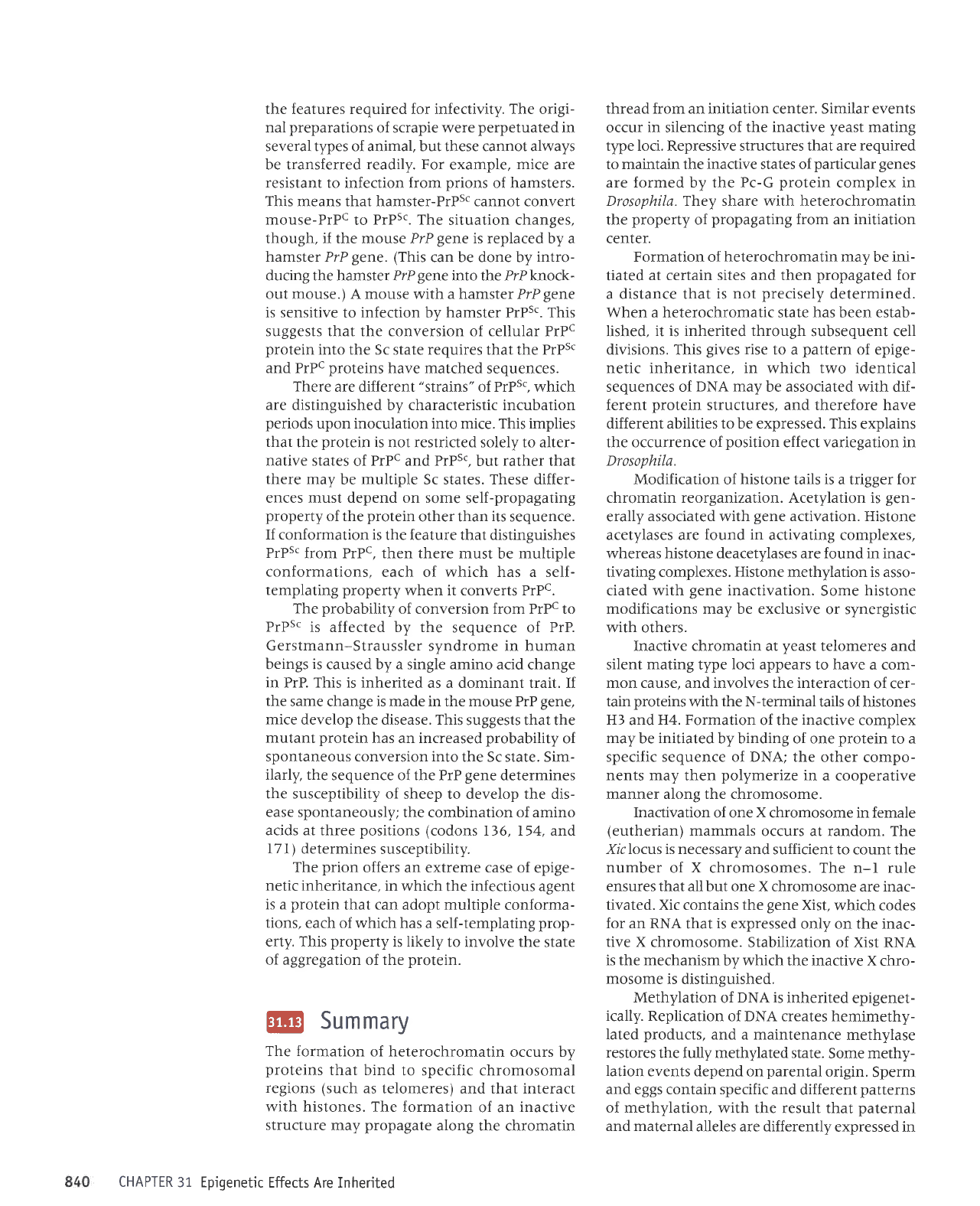
the features required for infectivity. The origi-
nal
preparations
of scrapie
were
perpetuated
in
several types of animal, but these cannot always
be transferred readily.
For
example,
mice
are
resistant
to infection from
prions
of hamsters.
This means that hamster-PrPst cannot convert
mouse-PrPc
to
PrPsc. The
situation changes,
though, if the mouse PrP
gene
is replaced by a
hamster PrP
gene. (This
can be done by
intro-
ducing the hamster PrP
gene
into the PrP knock-
out mouse.) A mouse with a hamster PrP
gene
is sensitive
to
infection
by
hamster PrPsc. This
suggests that the conversion of cellular PrPc
protein
into the Sc state requires
that the
PrPsc
and PrPc
proteins
have
matched sequences.
There
are different
"strains"
of PrPs', which
are distinguished by characteristic incubation
periods
upon inoculation into mice. This implies
that
the
protein
is not restricted solely to alter-
native states
of
PrPc
and
PrPsc,
but
rather
that
there may
be multiple Sc states. These differ-
ences must depend on some
self-propagating
property
of the
protein
other than
its
sequence.
If conformation is
the feature that distinguishes
PrPs'from
PrPc, then there must
be
multiple
conformations,
each of which has a self-
templating
property
when it converts PrPc.
The
probability
of conversion from PrPc to
PrPsc
is affected by the
sequence of
PrP.
Gerstmann-Straussler
syndrome in human
beings
is
caused by a single amino
acid change
in PrP. This is inherited
as a dominant trait. If
the
same change is made in the mouse PrP
gene,
mice
develop the disease. This
suggests that the
mutant
protein
has an increased
probability
of
spontaneous conversion into
the Sc state. Sim-
ilarly, the
sequence of the PrP
gene
determines
the susceptibility of
sheep to develop the dis-
ease spontaneously;
the combination of amino
acids at three
positions (codons
I)6, I54, and
l7l
)
determines
susceptibility.
The
prion
offers an extreme case
of epige-
netic inheritance,
in which
the
infectious
agent
is a
protein
that can adopt multiple
conforma-
tions.
each of
which
has
a self-templating
prop-
erty. This
propefiy
is likely
to involve rhe
srare
of aggregation of the
protein.
@
Summary
Ihe formation
of heterochromatin
occurs by
proteins
that bind
to specific chromosomal
regions
(such
as
telomeres) and that interact
xt:l,llT
nT
Jffi:T:,H
:i J :,":il:T;
CHAPTER
31 Epigenetic
Effects Are Inherited
thread from an initiation center. Similar events
occur
in
silencing
of the inactive
yeast
mating
type loci. Repressive structures that are
required
to maintain the inactive states of
particular genes
are formed by the Pc-G
protein
complex in
Drosophila. They share with heterochromatin
the
property
of
propagating
from
an
initiation
center.
Formation of
heterochromatin
may be ini-
tiated
at certain sites and then
propagated
for
a distance that
is not
precisely
determined.
When
a heterochromatic state has been estab-
Iished.
it is inherited through
subsequent cell
divisions. This
gives
dse
to a
pattern
of epige-
netic inheritance, in which two identical
sequences of
DNA may
be associated with dif-
ferent
protein
structures, and therefore have
different abilities to be expressed. This
explains
the occurrence of
position
effect variegation in
Drosophila.
Modification of
histone
tails is a trigger for
chromatin reorganization. Acetylation is
gen-
erally
associated with
gene
activation. Histone
acetylases are found
in
activating complexes,
whereas histone deacetylases are found in
inac-
tivating complexes. Histone methylation is asso-
ciated with
gene
inactivation.
Some
histone
modifications may be exclusive
or synergistic
with others.
Inactive chromatin at
yeast
telomeres
and
silent
mating
type
loci
appears to have a com-
mon cause, and involves the interaction
of cer-
tain
proteins
with
the
N-terminal tails of histones
Hl
and
H4. Formation
of the
inactive
complex
may
be
initiated
by binding of one
protein
to a
specific sequence of DNA; the
other compo-
nents may
then
polymerize
in a cooperative
manner along the chromosome.
Inactivation
of one
X
chromosome in female
(eutherian)
mammals
occurs at random. The
Xrclocus is necessary and
sufficient to count
the
number
of
X
chromosomes. The n-I rule
ensures that allbut one X
chromosome are inac-
tivated. Xic contains the
gene
Xist,
which codes
for an RNA
that
is
expressed only on the inac-
tive X
chromosome. Stabilization
of
Xist
RNA
is the mechanism
by which the inactive X
chro-
mosome
is distinguished.
Methylation
of
DNA is
inherited
epigenet-
ically. Replication
of DNA creates hemimethy-
lated
products,
and a maintenance
methylase
restores
the fully methylated state.
Some methy-
lation
events depend on
parental
origin.
Sperm
and eggs contain specific
and different
patterns
of methylation,
with the result that
paternal
and maternal
alleles are differentlv
exnressed in
